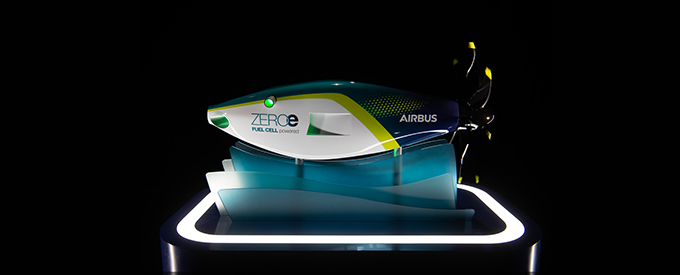2023-01-01
Airbus’ Zero-emission Engine Unveiled
Airbus has revealed that it is developing a hydrogen-powered fuel cell engine for its ambitious zero-emission aircraft that is expected to enter service by 2035.
Hydrogen is a high-potential technology with a specific energy-per-unit mass that is three times higher than traditional jet fuel. If generated from renewable energy through electrolysis, it emits no CO2 emissions, enabling renewable energy to potentially power large aircraft over long distances but without the undesirable by-product of CO2 emissions.
Aircraft Modification
Airbus will start flight testing this fuel cell engine architecture onboard its ZEROe demonstrator aircraft towards the middle of the decade. The A380 MSN1 flight test aircraft for new hydrogen technologies is being modified to carry liquid hydrogen tanks and associated distribution systems.
Glenn Llewellyn, VP Zero-Emission Aircraft, Airbus, explained: “Fuel cells are a potential solution to help achieve our zero-emission ambition and we are focused on testing this technology to understand if it is viable for a 2035 entry-into-service of a zero-emission aircraft. At scale, and if the technology targets were achieved, fuel cell engines may be able to power a 100-passenger aircraft with a range of approximately 1,000 nautical miles.”
Two Ways
There are two ways hydrogen can be used as a power source for aircraft propulsion. First, via hydrogen combustion in a gas turbine. Second, by using fuel cells to convert hydrogen into electricity in order to power a propeller engine. A hydrogen gas turbine can be coupled with fuel cells instead of batteries in a hybrid-electric architecture.
Fuel-cells — originally invented by Sir William Grove in 1838 — generate electricity very efficiently through an electrochemical reaction, rather than via combustion. They also differ from batteries since they require a continuous source of fuel and oxygen (usually from air), whereas in a battery the chemical energy comes from substances which are already present inside the battery.
Fuel cells can produce electricity continuously for as long as fuel and oxygen are supplied.
The most promising technology for mobile applications is called Proton Exchange Membrane (PEM). In this type of fuel-cell, hydrogen is used as the “fuel” to directly generate electricity. With this type of fuel cell the only by-products are heat and water.
Having this technology on board an aircraft is particularly attractive since it does not generate CO2, NOx, and potentially forms no contrails, or very limited ones.
Stacking Fuel Cells
As one single fuel cell is only a few millimetres thick and roughly the size of a letter envelope, it does not release much energy. In order to realise sufficient power levels for use in an aircraft, hundreds of these fuel cells need to be electrically connected in series to form a “stack”. Several such stacks are combined into multiple fuel cell “channels”. With this modular approach, the megawatt levels of power — which are needed for an electric aircraft — are achievable.
While fuel cells themselves are already used in some automobiles, they do not fulfil the stringent requirements necessary for aeronautical use. Nevertheless, it made sense for Airbus to look towards the automotive industry for a prospective partner and provider, with whom to take fuels cells to the next level — to produce specially tailored fuel cell stacks and industrialise them for the aviation industry.
In October 2020, Airbus created Aerostack, a joint venture with ElringKlinger, a company with over 20 years of experience as both a fuel cell systems and component supplier.
Aerostack has also joined forces with other stakeholders, and those who are working on fuel-stack development as part of a German government supported project called H2Sky.
Two years after Aerostack was formed, the collaborative work is well underway. The first prototype fuel cell stacks are being evaluated by Airbus in Hamburg, where the teams are designing fuel cell systems, assembling and testing them.
“We are doing everything from scratch at quite an impressive speed,” says Hauke Peer Lüdders, Head of Fuel-Cell propulsion systems for ZEROe Aircraft at Airbus. “We need to understand how fuel cell systems work and react. For that first step we are designing large ones to accommodate many sensors inside which allow us to analyse each equipment in the system, with good accessibility in order to tailor, test and fully understand the system behaviour,” he explains.
Testing Process
Once the teams have tailored the entire fuel cell systems, it’s time to test them. First they need to make sure it is properly connected to the auxiliary system, the test bed, comprising hydrogen, nitrogen (for the tests only), coolant and air supplies, as well as a drainage outlet (for the derived water by-product). After the doors of the test bench are closed, the power is switched on and the process gets underway.
Subsequently the teams can monitor, via special screens, the ongoing reaction, the production of by-products and the electrical power generated .


No Comments